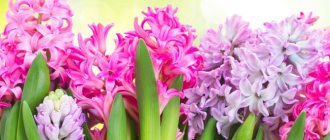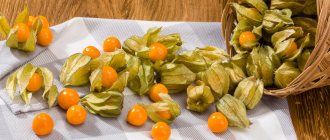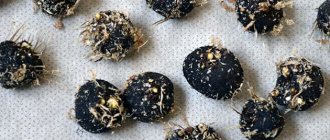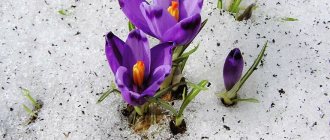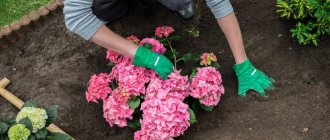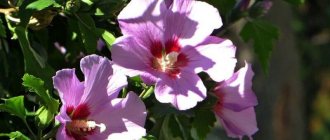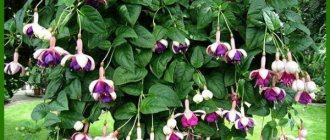Author: Tamara Altova. August 31, 2018
Category: Garden plants.
Hyacinth (lat. Hyacinthus) is a genus of bulbous plants of the Asparagus family. Previously, this genus was classified as a separate family Hyacinthaceae or included in the Liliaceae family. Some researchers count up to 30 species in this genus, others consider the genus to be monotypic, that is, including one species, but with a large number of forms and varieties. In the wild, hyacinths grow in Central Asia and the eastern Mediterranean, but in cultivation they are grown everywhere.
The hyacinth plant received its name in honor of the hero of the ancient Greek myth - a beautiful young man who was the lover of Apollo and died due to the jealousy of the wind god, who was also in love with Hyacinth. In memory of his dead friend, Apollo created a beautiful hyacinth flower from his blood.
In 1543, hyacinth was brought from Asia Minor to the botanical garden of Padua, in northern Italy, and gradually became a flower of luxury: it was grown in the gardens of the rich and aristocrats. In the 18th century, Dutch breeders showed interest in hyacinth, fascinated by its aroma and dense texture of petals, and soon white, cream, soft lilac, raspberry, blue and, eventually, even yellow hyacinths appeared. They were developing new varieties of this plant in both Germany and France. Today, hyacinths are grown not only in gardens, but also at home, and recently it has become popular to plant hyacinth bulbs for forcing in order to get a beautiful flower by a certain date.
Hyacinth flower - description
The perennial hyacinth has a dense bulb, consisting of lower, fleshy leaves that occupy the entire circumference of the bottom, the direct continuation of which is the peduncle. A racemose inflorescence of brightly colored bell-shaped flowers with bent perianth lobes is formed on the stem. After flowering is completed, the stem and the green leaves sitting at the very bottom dry out, but a bud forms in the corner of the upper leaf, which will become a bulb and produce a peduncle next season. Bulbs can also form in the corners of other hyacinth leaves, which can be separated and grown so that after a few years they also throw out flower shoots. The hyacinth fruit has the appearance of a leathery three-lobed capsule, in each nest of which two seeds ripen.
Biological features of hyacinth
Hyacinths are perennial herbaceous ephemeral plants. They vegetate in the spring, and during the hot summer and cool winter they “hibernate.” The hyacinth bulb is large (4–6 cm in height and about the same in diameter), round, covered with thin filmy scales, lives up to 10 years. After this, flowering weakens.
From 5–6 years of age, daughter bulbs begin to appear. With their help, vegetative (not seed) propagation of hyacinths occurs. The leaves are elongated, narrow, relatively short during flowering, then growing up to 20 cm. The racemose inflorescence on a thick fleshy peduncle can reach 30 cm in height.
The flowers are 12–35, bell-shaped, on short stalks, very fragrant. In the wild species, the corolla is usually blue or white.
Varietal hyacinths have pink, red, purple, dark purple, blue, yellow, and orange. There are terry varieties.
Planting hyacinths in open ground
Soil for hyacinths
These early flowers are grown in well-lit places protected from the wind, away from bushes and trees, the roots of which do not allow hyacinths to fully develop. In the area where hyacinths grow, melt and rain water should not stagnate, so you need to choose places with a flat surface or a slight slope for planting flowers. Groundwater should lie on the site no closer than at a depth of 50 cm.
Hyacinths prefer well-drained soils with a high content of humus, but fresh or incompletely decomposed manure is not suitable for fertilizing the site. Peat and river sand must be added to clay soil for digging, and acidic soil must be neutralized with limestone or chalk, since hyacinth needs a pH of at least 6.5 units.
When to plant hyacinth
The area for hyacinths needs to be prepared at the end of summer, in August, so that the soil has time to settle two months before planting. If you dig up the area immediately before planting, then as a result of natural subsidence of the soil, the developing roots of hyacinths may break off. Dig the soil to a depth of 40 cm, adding 10-15 kg of humus, 60-80 g of superphosphate, 15 g of magnesium sulfate (or 250-250 g of dolomite flour) and 30 g of potassium sulfate (or 150-200 g of wood ash) per m². ). Peat and sand are added to clay soil, and when processing sandy soil, the rate of magnesium and potassium fertilizer is increased by one and a half times. Acidic soil is limed two weeks before fertilizing.
Hyacinths are planted at the end of September or in October - the specific dates depend on the climatic and weather conditions of the area. If you plant hyacinths too early, they will grow and die in winter, and if you are late with planting, the bulbs will not have time to take root before the soil freezes and, at best, they will simply lie in the ground until spring, and at worst, they will die.
Planting hyacinths in the ground
When choosing planting material, you should give preference to medium-sized bulbs, the so-called “flower beds”: hyacinths grown from them form flower shoots that are more weather-resistant. Bulbs that are flaccid, soft, rotting or with mechanical damage are not suitable for planting. Healthy planting material is pickled for half an hour in a fungicide solution and planted in the ground.
The distance between the holes in the row should be approximately 15-20 cm, and between the rows - 20-25 cm. Planting is carried out to a depth of three diameters of the bulb, that is, there should be a layer of soil above the bulb two times its diameter. A layer of dry coarse sand 3-4 cm thick is poured onto the bottom of the hole, then a hyacinth bulb is placed, lightly pressing it into the sand, after which the bulb is filled to the top with sand, and the remaining space in the hole is filled with soil. This planting method is called a “sand jacket”; it can be used when planting any bulbous plant to avoid rotting of the bulbs from stagnant water. If you planted hyacinths in dry soil, the area should be watered after planting.
Selection and preparation of hyacinth planting material
Before planting, it is also important to choose high-quality planting material. There are several signs that will help you identify suitable specimens:
- bulb diameter – 4-6 cm (in yellow and terry varieties it may be slightly smaller);
- the diameter of the bulb is approximately 1.5 times the circumference of the bottom;
- the bulbs are clean and beautiful;
- The bulbs are dense, elastic and healthy.
Before planting, it is advisable to pickle hyacinth bulbs in a solution of the available fungicide - Maxim, Fundazol, Khoma (follow the instructions on the package).
Caring for hyacinths in the garden
How to care for hyacinths. Watering hyacinths
Caring for hyacinths includes weed control, loosening the soil, fertilizing and, if necessary, watering. Plants will need moisture only during periods of abnormal drought: in the spring, when hyacinths are growing, the ground is saturated with melt water, so there is no need to water the area. If the winter was snowless and spring without rain, then watering the hyacinths is carried out in such a way as to wet the soil 15-20 cm deep - to the level of the bulbs and roots. You can make your work easier by mulching the surface of the area with organic materials that will prevent moisture from quickly evaporating and weeds from germinating. After watering or rain, you need to loosen the surface of the area to a shallow depth several times a season.
Feeding hyacinths
Hyacinths are fed 2-3 times per season, and fertilizers are applied both in the form of granules and in the form of a solution. However, if you prefer to fertilize the soil with nutrient solutions, keep in mind that you need to put less fertilizer in them than with the dry method. The first feeding is carried out at the very beginning of active growth. It consists of 20 g of superphosphate and 25 g of nitrate per 1 m², which are scattered over the surface of the area. When preparing the solution, the dosage of each ingredient per unit area is reduced by 5 g. The second time, hyacinths are fed during the budding period at the rate of 20 g of potassium sulfate and 35 g of superphosphate (for the solution, the dosage of both elements is reduced by 5 g), and the third feeding is carried out after flowering is completed , and it consists of an equal amount (35 g for the dry method and 30 g for the solution) of potassium sulfate and superphosphate for each m² of area.
Storing hyacinth bulbs
Storage varies for purchased flowering plants and those grown on site. In the first case, after flowering, the peduncle is cut off. If the plant grew in a small container, then it is transplanted into a larger pot. After trimming the peduncle and replanting, the hyacinth is placed in a cool, well-lit place. It can be placed close to the window glass. There he will have enough light and the temperature will be low.
Hyacinth should be watered sparingly during storage. In May - June, the preserved bulb is transplanted into a flower garden.
Storage option
Plants growing in the garden are dug up after flowering and replanted in the fall before winter. In summer, the bulbs are stored in a cool, dark room.
Hyacinths after flowering
When to dig up hyacinths
Digging up hyacinth bulbs in the summer. After flowering is completed, hyacinths are fed with phosphorus-potassium fertilizers, then the bulbs are given some time to restore the strength expended on flowering. When the leaves of the plants begin to turn yellow and wither, you can start digging up the bulbs, but it is not necessary to wait for the ground organs to completely wither.
Transplanting hyacinths. How to store hyacinth bulbs
If you want hyacinths to bloom magnificently every spring, you need to replant them annually: dig them up, separate the children and plant them in the ground again in the fall. The bulbs removed from the ground are washed under running water, pickled for half an hour in a three percent solution of Karbofos or for 10 minutes in a thermos with water at a temperature of 50 ºC, after which they are dried for a week in the shade at a temperature of 20 ºC, freed from remnants of roots and dry scales, large children are separated and laid out planting material in one layer in boxes, sorted: small bulbs - in one box, large ones - in another. If there are only a few bulbs, you can store them in paper bags.
The storage period of hyacinth bulbs is divided into two stages: the first two months they are kept at a temperature of about 25 ºC, the third month the storage temperature is reduced to 17 ºC. There should be free air circulation in the room and moderate humidity so that the bulbs do not rot or dry out. During storage, small children may appear on the bulbs, so be careful when planting.
Planting after a dormant period
A dormant period is necessary for the development of the flower bud. After the dormant period, it is time for planting activities. For indoor and outdoor plants, there are differences in timing and planting techniques.
In a potty at home
The planting date is determined by the date of expected flowering. They count from it a month ago, adding a cooling period of at least 2.5 months. Planting process :
- Make holes at the bottom of the pot to drain water and put drainage - sand, fine gravel, expanded clay, gravel, moss;
- Place nutritious loose soil on the drainage;
- keep the onion in a weak solution of potassium permanganate for 30 minutes in advance;
- plant the bulb so that the upper third protrudes above the ground;
- the pot is placed at a temperature of 10oC and periodically moistened;
- if the sprout size is 5 cm, transfer to 12oC;
- when an unopened inflorescence appears, move it to a window or loggia;
- turn evenly towards the light source every 2-3 days.
Note ! It is not advisable to force one bulb two years in a row; the plant is given one season to recuperate.
In open ground
Planted in open ground from late September to early October according to the rules:
- from August, they dig up the planting site with humus and mineral fertilizers;
- make a planting groove 15-20 cm deep;
- river sand is poured onto the bottom in a layer of 3-5 cm for drainage;
- place the bulbs in the groove at a distance of 15 cm from each other;
- lightly press them into the soil;
- a small layer of sand is again poured on top;
- cover with earth to the edges of the furrow;
- Water moderately.
With the arrival of the first cold weather, it is necessary to cover the furrow with hay, sawdust or spruce branches so that the hyacinths do not freeze in winter. In spring, remove the coating.
Propagation of hyacinths
In addition to the vegetative method of propagation by children, which we have already described, hyacinths are propagated by seed. Hyacinth seeds are sown in boxes with soil consisting of two parts humus, one part leaf soil and one part sand, and the crops are placed in a cold greenhouse, in which hyacinths are grown for two years before planting the bulbs in open ground. However, the seed method does not preserve the varietal characteristics of the parent plants in the offspring, and therefore is only suitable for propagating specific hyacinths or for breeding new varieties.
Professional flower growers prefer to propagate hyacinths in this way, such as cutting out the bottom. The tool used is a sterile teaspoon with a sharp edge, which is used to cut out the bottom, removing the bases of the scale-like leaves and leaving the rest of the bulb intact. To avoid the development of infection, the surface of the cuts is treated with a fungicide, after which the bulbs are placed cut side up on a tray with sterile sand and kept at a temperature of at least 21 ºC until callus forms. After 65-90 days, from 20 to 40 children are formed on the sections of each bulb. These nests are placed in pots so that the babies are slightly covered with soil. After two weeks of hardening procedures, the pots are transferred to cold greenhouses. In the spring, the young bulbs will begin to form leaves, gradually destroying the mother bulb. At the end of the season, young plants are separated and planted for growing. They will bloom in the third or fourth year.
How to care for hyacinths in spring
Hyacinths are quite thermophilic. They bloom in late April - early May, depending on the variety, and finish blooming in early June.
Hyacinths are demanding on soil structure; you need to periodically top the soil around them. At the same time, you can apply: immediately after planting and after the formation of buds.
Hyacinths are not very demanding when it comes to watering, but the soil should not dry out. Moderate shallow watering is needed, the amount of water increases before flowering and two weeks after it.
If you strictly follow all the recommendations, then in the spring you will be one of the first to enjoy the beauty of your flower garden.
Diseases and pests of hyacinths
Hyacinth diseases and their treatment
Hyacinths grown in open ground are extremely resistant to infections. Greenhouse and forced plants suffer from diseases more often. If storage conditions are violated, hyacinth bulbs can be affected by penicillosis, or storage rot, which is caused by fungi of the genus Penicillium. Penicillosis pathogens are activated when bulbs are stored at temperatures below 17 ºC in conditions of high humidity. Planting material with mechanical damage is especially susceptible to infection. A sign of penicillosis is drying of the ends of the roots, which is usually detected before planting. If you make a cut just above the bottom, you can see that the internal tissues have acquired a light brown tint. Invisible from the outside, the rotting process continues during and after planting infected bulbs, which either do not form roots at all or do not form enough roots. In such plants, the flower stalks do not gain height and break easily. In places of infection, fungal colonies appear on the bulbs, the tissues become soft and darken.
To avoid the development of infection, store hyacinth bulbs in a well-ventilated area, with air humidity not exceeding 70%, and immediately plant bulbs with prematurely grown roots in the ground.
Yellow bacterial rot can affect hyacinths, turning plant tissue into foul-smelling mucus. Symptoms of the disease include stunted growth, the appearance of spots and stripes on the leaves and flower shoots, and then rotting areas. The bulbs also suffer from the disease. When the first signs of bacterial rot are detected, the diseased plant should be dug up and burned, and the place where it grew should be spilled with a five percent solution of Formalin or bleach.
Pests of hyacinths and their control
Of the insects, garden hyacinths are pestered by flower flies, the larvae of which feed on the tissues of the bottom of the bulb. Flies are destroyed before laying eggs by treating the plants and the soil around them with a solution of the drugs Fly Eater, Tabazol or Aktara.
The meadow mite is also an enemy of hyacinths. Its activity occurs in late spring and early summer. The main danger of arachnids is that they are carriers of incurable viral diseases. Plants infected with mites have bent flower stalks, and leaves turn yellow and wither prematurely. Ticks are destroyed with acaricides - Actellik, Talstar Pro or other drugs of similar action.
A danger to hyacinths are mole crickets that damage flower bulbs directly in the ground. The activity of these insects begins in May, when they crawl out of the sun-warmed ground. To collect and destroy all pests, dig shallow holes in the area, spread fresh manure or half-rotted straw in them and cover the top with old slate or a piece of board. The mole crickets will crawl into the traps to lay eggs in them, and after 3-4 weeks you can begin to destroy them. Among pesticides, Medvetox, Medvezhatnik, Boverin, Grizzly, Thunder and other drugs of similar action have shown effectiveness in combating pests.
When to dig and how to store hyacinth bulbs
By the way! If crocuses and daffodils can not be dug up for 3-5 years, then hyacinths are advised to be disturbed and taken out of the ground every year . Although some gardeners successfully leave these bulbous bulbs to grow in the garden for up to 3 years, it is worth understanding that a flower bud is formed only if the bulb lies for 3 months in a warm and dry room.
Hyacinth bulbs, as a rule, are carefully dug up (stepping back 8-10 centimeters from the bush) after their leaves have withered, dried out (but not completely) and turned yellow (approximately in May-June, about 3 weeks after flowering). Then they should be thoroughly rinsed under water to immediately discard low-quality bulbs.
Now the future planting material needs to be disinfected in one of the special means, such as Maxim Dachnik or Fundazol, or prepare a pink solution of potassium permanganate. Next, dry it well, and before storing it, peel it (if desired, you can wrap it in newspaper) and put the bulbs in boxes (for example, from under shoes), bags or containers and store them in a warm and dry place. It is noteworthy that you need to store it for the first time at a fairly high temperature (+25-..+30 degrees), and then gradually lower it so that before planting it is about +17 degrees.
If during digging you see children on the bulbs, then you can separate them and thereby multiply the hyacinths, saving them in the summer and planting them separately in the fall.
If you purposefully decide to grow hyacinths in open ground in the fall and spring, then choose the appropriate variety and correctly determine the timing of planting in the ground. It is also very wise to prepare the bulbs and soil for planting in advance. It is equally important to know how to store hyacinths.
Video: planting, care, growing, digging and storing hyacinths
Types and varieties of hyacinths
All garden forms and varieties originate from the oriental hyacinth and its two varieties: Roman hyacinth, or oriental white, and Provencal hyacinth. Varieties are distinguished by the size of the inflorescences, the length of the peduncle and the timing of flowering. In the last category, hyacinths are divided into early, mid-blooming and late . The difference between the beginning of flowering of early and medium, medium and late varieties of hyacinth is no more than two weeks. The most interesting garden plants include:
- Amethyst is a hyacinth up to 25 cm high with a dense, wide-cylindrical inflorescence up to 9 cm long, consisting of 18-20 soft purple flowers up to 4 cm in diameter. Flowering begins in late April or early May and lasts about a week;
- Arentina Arendsen - a variety up to 28 cm high with a cylindrical inflorescence of 20-22 white flowers up to 4 cm in diameter. Flowering begins in mid-April;
- Bismarck is a hyacinth up to 28 cm high with a large cylindrical inflorescence up to 13 cm long of 20-25 light purple flowers up to 4.5 cm in diameter. It blooms for about two weeks from mid-April;
- General de Wet is a plant up to 24 cm high with a medium-density inflorescence up to 11 cm long of 18-20 white-pink flowers up to 2 cm in diameter with strongly twisted perianth lobes. Flowering begins in mid-April;
- Grand Lilac is a hyacinth up to 35 cm high with inflorescences up to 11 cm long, consisting of 15-20 porcelain-blue flowers up to 4 cm in diameter with lighter ends of the perianth segments. Flowering begins at the end of April and lasts up to two weeks;
- Grand Maitre is a variety up to 28 cm high with a loose inflorescence up to 10 cm long of approximately 18 light blue-purple flowers with narrow and strongly curled perianth lobes. Blooms at the end of April;
- Grootwort is a hyacinth up to 30 cm high with a loose inflorescence 13 cm long of 5-15 double flowers of a dirty light lilac hue, which begin to open in April or early May;
- Indigo King is a plant up to 25 cm high with a loose inflorescence up to 10 cm high of 7-18 black-purple, inky flowers up to 3 cm in diameter. It blooms for about two weeks from the end of April;
- Yellow Hammer - a variety up to 30 cm high with a dense inflorescence up to 12 cm long of 20-25 light yellow flowers up to 3 cm in diameter, opening at the end of April;
- Lord Balfour is a hyacinth with a peduncle up to 24 cm long, bearing a loose inflorescence of 8-13 purple-violet flowers up to 4 cm in diameter with lighter ends. Flowering begins at the end of April and lasts up to three weeks;
- Madame Sophie is a hyacinth up to 25 cm tall with a loose inflorescence up to 15 cm long, consisting of 15 white double flowers up to 3.5 cm in diameter. Flowering begins at the end of April and lasts about two weeks;
- Prince Arthur is a variety up to 30 cm high with a medium-density inflorescence up to 14 cm long, consisting of 13-16 double flowers up to 3.5 cm in diameter. It blooms from late April for 15-18 days;
- Rosalia is a variety only 20 cm high with a narrow cylindrical inflorescence up to 8 cm long, consisting of 10-15 bright pink flowers up to 2 cm in diameter. It blooms from the beginning of April;
- Chestnut Flower is a hyacinth up to 25 cm high with a loose inflorescence up to 12 cm long of 12-15 light pink double flowers up to 4.5 cm in diameter with strongly curled perianth lobes. Blooms at the end of April;
- Edelweiss is a plant 20-25 cm high with a dense wide inflorescence up to 11 cm long, consisting of 13-20 white flowers up to 3.5 cm in diameter. Flowering begins in mid-April;
- Edison is a hyacinth up to 22 cm high. The loose inflorescence consists of 7-10 double pink flowers up to 3.5 cm in diameter. Flowering begins at the end of April.
3.5 Rating 3.50 (2 Votes)
- Back
- Forward
Variety of hyacinths
For gardeners, the most interesting classifications of hyacinths are based on the growing season and flower color. “Early” varieties bloom until mid-May, “middle” varieties – on May 15-23, “late” – in the third ten days of the month. Flowering of each group of plants lasts only a couple of weeks. The height of the peduncles varies from 20 to 35 cm, and the number of flowers - from 20 to 50.
Through the efforts of breeders, a wide range of hyacinth colors has been created.
The existing assortment includes varieties and hybrids with buds of the following colors:
- snow-white (“Antarctica”, “Carnegie”, “L’Innocente”, “Madame Sophie”);
- yellow (“City of Haarlem”, “Yellow Queen”);
- pink (“Delight”, “Anna Lisa”, “Rosalia”, “China Pink”);
- red (“Red Magic”, “Jan Bos”);
- purple (“Woodstock”, “L’Esperance”);
- purple (“Amethyst”, “Blue Pearl”);
- blue (“Blue Star”, “Sky Jacket”, “Azure”);
- blue (“Delft Blue”, “Aida”, “Blue Jacket”);
- black (“Midnight Mystic”, “Dark Dimension”).
In addition, flowers can have a simple or double shape and inflorescences of different configurations - from conical to ovoid.
When choosing crop varieties, the dimensions of the plants, the size and shape of the inflorescences are also taken into account.
Cultivating hyacinths is not particularly difficult and is accessible even to novice gardeners, and the variety of planting material on the market makes it possible to create beautiful spring compositions in almost any garden.
Is it possible to plant hyacinths in spring?
According to experienced gardeners, it is not advisable to plant hyacinths in open ground in the spring, but it is possible. The problem may be that it goes against the biological rhythm of that plant. After all, for its lush flowering, the bulb must have time to grow the root system, and this is not always possible, since at a temperature of +10 degrees the flower arrow begins to grow.
Therefore, if it is necessary to plant hyacinth bulbs in open ground in the spring, then this must be done taking into account this feature. Otherwise, the plant will not have enough strength to simultaneously grow a root and form a peduncle.
Is it possible to plant flowering hyacinths from a pot into open ground in spring?
Many women receive flowering hyacinths planted in pots as a gift on March 8th. These plants underwent a special cooling regime for forcing by this date. But it is no longer possible to plant hyacinths in open ground in the spring from a flowering pot, since their life cycle is coming to an end.
In this case, it is necessary to leave the plant at home and water it moderately with cold water as the earthen clod dries out. And to prolong flowering, keep it in a cool room. This care should be followed throughout the spring until the plant begins to fade. After this, watering should be stopped and placed in a pot in a shaded place. And when the leaves are completely dry, remove the bulb from the ground, soak it in the Maxim solution to disinfect and dry it. In this case, planting in open ground should be carried out at the end of August or at the beginning of September.
Important! It is impossible to cut off the green leaves of the plant until the plates dry out on their own, as they provide nutrition to the bulb.
How to grow hyacinth from seeds
The main method of propagating the crop is bulbous, but sometimes gardeners practice seed propagation. Most often this happens when you want to experiment with breeding new varieties, but in amateur breeding this is impractical, since flowering in such specimens begins only in the 6th year.
Read more about the characteristics of hyacinth propagation.
Cultivation by seeds provides for the following conditions:
- Seeds are harvested from unopened light yellow boxes, which after collection need to be dried and stored in paper bags;
- The optimal time for sowing is the end of September. In this case, seedlings will appear in the spring of next year;
- Seedlings can be grown either in any container or in a garden bed;
- a suitable substrate for planting can be a mixture of equal volumes of peat, turf and sand;
- the sowing depth should not exceed 1.5 cm. If you sow deeper, the seed may not hatch and sprout;
- seeds sown in containers require a period of vernalization. To do this, the containers are left to overwinter in a cool place;
- in open areas of the beds with crops, sprinkle 20 cm of compost, mulch, leaves or other material;
- seedlings that sprouted after 4-5 months need to be provided with watering and sufficient lighting;
- For the first year, young bulbs overwinter in the ground. They should be covered with a layer of mulch. In the summer they need to be dug up and stored until planting;
- Plants grown in containers need to be replanted only after 2 years. The optimal wintering place for them may be a cold greenhouse.
Features of growing hyacinths
Many gardeners are interested in the question: how to plant a flower without damaging it?
Since it is considered heat-loving, it must be planted in a place that is well illuminated by sunlight. Under natural conditions it grows in very hot climates. The bulbs do not have a protective and dense skin, so excessive moisture contributes to their rotting. The plant must be planted only on a flat area, without holes or depressions.
The flower prefers soil that is light, loose and breathable . Many gardeners place a layer of drainage on the bottom, forming tall rows. Winds and drafts can destroy the plant, so the planting site should be well protected from the winds.
To ensure simultaneous flowering, bulbs should be of the same size and planted at the same level.
The sandy loam soil that is used to grow hyacinth must contain nutrients. To improve heavy soil, you need to add sand and organic matter .
To prevent the plant from being infected by various pests, it is necessary to change the location of the flower bed from time to time. It is recommended to do this every year. It can only be planted in its original place after three years. It is not recommended to grow a flower after other bulbous crops, such as:
When to plant and how to prepare the soil?
Recommended planting time is the first half of autumn.
If you plant a bulb too early, it will develop too early. In winter, such a plant dies. Late planting means that the plant does not have time to take root in the soil and adapt.
A couple of months before planting, organic, as well as potassium and phosphorus fertilizers are applied to a depth of at least 40 cm.
If the soils have a heavy granulometric composition, it is recommended to add sand. If the soil is highly acidic, it is necessary to dilute it with chalk or lime . The prepared area must be covered with boards to prevent weeds from growing.
in spring
It is not recommended to plant bulbs in spring. If the gardener decides to plant hyacinths during this period, it is recommended to purchase the bulbs in stores. Planting hyacinths in spring is based on several rules.
- Remove the peduncle after the plant fades.
- Then remove the plant along with the soil from the pot.
- At the planting site, make a hole as deep as the pot.
- Pour sand into the bottom of the hole.
- Place an onion with a lump of earth in the hole and cover it with soil.
- Water the planting site so that water does not get on the bulb.
Important ! The soil must settle before planting.
If frost occurs in the spring, the plant must be covered.
How to plant in the fall?
A week and a half before planting, the soil needs to be prepared .
After the soil settles, separate holes are made for each flower. Then sand and an onion are placed in the hole, around which a “sand cushion” 1.5 cm thick is created. Fertile soil is poured on top.
Bulbs should be planted at a depth three times their length. The distance between the holes is made equal to the planting depth .
After planting, the plant must be watered. If the soil is moist, then watering is not necessary. If you plant bulbs in one common bed, it is recommended to add more sand to the hole. But it is advisable to plant one flower per bed. When all the plants are planted, the flowerbed should be mulched with peat, straw or sawdust.
What happens if hyacinth is left in the ground?
World-famous Dutch flower growers believe that under no circumstances should hyacinth bulbs be left in the ground. All bulbous primroses, including hyacinths, after a period of flowering go into bulb maturation and then into a dormant state. At this time, they are very sensitive to changes in weather conditions: high humidity, temperature changes.
Bulbs left in the ground are at risk from rodents who are not averse to trying them. It is difficult for the emerging “babies” to survive and grow up in such conditions; most of them will die. In central Russia, conditions are extremely unfavorable; moreover, it is impossible to control the condition of the bulbs in the ground, which makes the process of digging them up mandatory.
Important! It is possible to create suitable conditions for the ripening and establishment of healthy flower buds, monitoring them, and maintaining the necessary conditions for storing planting material only if it is removed from the ground.
In southern regions with warm winters, you don’t have to dig up bulbs every season, but to conduct an inspection, separate the “babies,” and identify rodent-damaged and diseased bulbs, you will have to resort to this procedure. In addition, this contributes to the preservation of varietal characteristics and lush flowering.
Hyacinth care after flowering at home and in the garden does not cause any particular difficulties, but requires compliance with certain conditions and attention. It is necessary to dig up the bulbs in time, properly send them for storage, prepare the area for planting and plant them in the fall in time sufficient for rooting. In spring, again expect the appearance of new shoots and the miracle of the appearance of beautiful inflorescences.
The sight of a blooming hyacinth, especially if this plant is grown independently, makes its owner proud. The time and labor spent are returned with bright colors and the delicate aroma of an amazing flower.
How to replant hyacinth
Like most plants, hyacinths need to be replanted. Immediately after purchasing hyacinth forcing, it is advisable to move it to a large container. Before this, he must adapt a little to home conditions for about a week and a half.
After selecting a pot and preparing the mixture (how to do this was indicated earlier in the article), you can begin replanting:
- After removing the bulb, it needs to be inspected. If there is damage, they should be sprinkled with activated carbon.
- You can remove the top husk and treat it with a growth stimulator.
- Deepen the bulb to the root collar.
- Place the plant in a cool room and water periodically.
Purchased hyacinths can be moved not into pots, but into flower beds. The best time is autumn, but you can replant in the spring. The landing algorithm was given earlier in the text. The annual digging and replanting of hyacinth bulbs has already been mentioned in the article.
Transplanting hyacinths to another place in the fall
As we have already written, hyacinth bulbs are dug out of the ground every year. This is done in the summer, when the leaves and flower stalks wither - at the end of June or at the beginning of July. If you leave the bulbs in the ground, next year the flowering of hyacinths will be sparse. When are hyacinths transplanted - in spring or autumn? Like the primary planting, which is carried out from September to November, replanting hyacinths in the fall is most justified. It is carried out in the same time frame and according to the same procedure as the initial planting of hyacinths, which we described earlier.
- Wilting of clematis, drying out of albizia and shedding of wisteria - reasons and how to deal with them
How hyacinths overwinter
Before the onset of persistent cold weather, the area with hyacinths should be covered with a layer of dry leaves, sawdust, peat or humus. This is necessary to prevent soil freezing and death of the bulbs. In the spring, you need to remove the shelter in time (as soon as the soil begins to thaw), since hyacinths germinate early.
Now you know how to grow hyacinths. If you plant hyacinth correctly and care for it, it will delight you with early and abundant flowering for many years. This plant can bloom anywhere, be it a flower garden, a windowsill or a balcony.
When to plant hyacinths: basic planting rules
Not many people know that hyacinths are not an annual plant. Many inexperienced flower growers stop caring for them after flowering. Although, this is wrong. After the flower has dropped its leaves, it is necessary to cut off the stems. Well, of course, don’t forget to feed and water them.
The plant grows depending on when the grower wants to see its beauty. Hyacinth is planted in spring, autumn, and winter. If planting occurs in winter, then the flower is well covered so that it does not freeze. It is advisable to do this with film. In this case, it will need to be removed early, before flowering begins.
